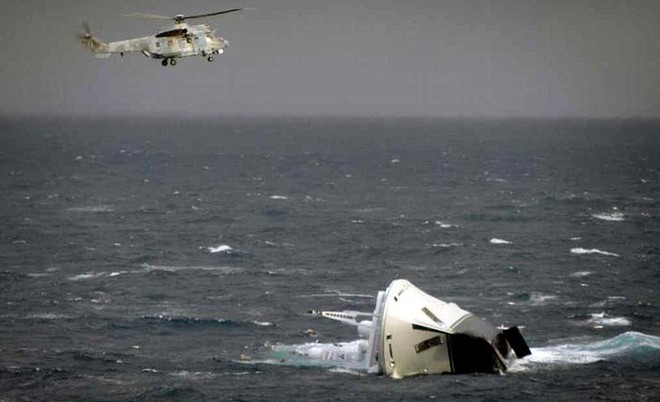Perfect storm of strong desire, weak skill may have sunk Yogi
by Gordon Reid on 8 Jul 2012

Last sight of the 60m motor yacht Yogi, which sank in Greek waters in February SW
In February this year a yacht which had just won accolades as 'The Most Innovative Yacht for 2011', the motoryacht Yogi, sank in Greek waters (see Sail-World http://www.sail-world.com/CruisingAus/Most-Innovative-yacht-in-mystery-sinking/94002!story). Here yachting writer Gordon Reid, also a professional yacht consultant and delivery captain, talks about how poor seamanship may have been responsible for the sinking of the 60m yacht:
I’m an old sea-dog. I can recognize a storm brewing.
The 'perfect storm' can be described as the collision of two weather systems: one a high pressure, cold stable air mass circulating in a clockwise direction (in the northern hemisphere); the other a depression or low pressure warm air mass circulating in a counterclockwise direction.
I offer this metaphor to describe an emerging phenomena in the yachting industry in Asia. More than $500 million will be spent on yachts and equipment in the next 12 months. Most aspiring owners are long on love of yachts and yachting, but a wee short on seamanship and practical experience, hence a perfect storm.
The recent sinking of the 60m M/Y Yogi in a mistral off Skyros, Greece, has popped yacht safety onto the front page of industry publications. Not to put too fine a point on this accident, but it begs more questions than it answers.
M/Y Yogi foundered due to what the Greek Coast Guard reported as mechanical failure. In other words, the engines stopped.
The usual suspect when this occurs in heavy weather is fuel starvation. My hypothesis goes something like this: During construction the fuel tanks are exposed to litter from construction crews. The plot thickens when the first force eight gale begins to stir the pot.
Inertia forces sediment off the bottom of the tank and into suspension in the fuel. Small particles of foreign matter begin to clog the screens on the fuel pick-up pipes. Soon, the fuel pumps are working overtime to maintain pressure to the injectors. The injectors begin to 'hunt' for fuel pressure; engines rev up and down without throttle control and die. The emergency begins.
Without power, the yacht lays a-hull, at the mercy of beam seas. She rolls rail to rail through an arc of almost 180 degrees. Imagine the rinse cycle in a washing machine; imagine searching for the source and solution to the malfunction in such a cycle. The chief engineer cannot work alone and the skipper should not leave the bridge. The rest of the crew may be willing, but they may be ill equipped to achieve a re-start in a roller-coaster engine room full of scalding iron.
Waves crash into vulnerable top deck ports and hatches; cute French doors crash and allow the sea access to below decks. The yacht lists, which signals the final throes. The only maneuver that can save a yacht in these conditions is to deploy a sea anchor, which is usually not standard equipment on a designer yacht. The crew is ordered to abandon ship. The yacht fills with seawater and goes down by the head.
By contrast, long line tuna boats routinely fish in ocean conditions far worse than a force eight mistral in the Med. But their power systems are routinely maintained by professional crews, and their ports, hatches and doors are small in size and indestructible in construction. Modern expedition yachts are also well designed and built to take a sea.
Who is responsible for clean fuel tanks on a new yacht: the construction crew, yard manager, president of the shipyard, insurance agent, brokerage firm, sales agent, dock master, delivery captain, regulatory agencies, owner?
Reality is that that none will fill this role.
The design flaws of the modern motoryacht are hatched on the palette of the marine architect usually as a result of modern aesthetics. Professional skippers have to operate yachts within design parameters. In some cases, this means they must reschedule trips to avoid bad weather and adverse sea conditions, often to the dismay of owners.
Mechanical malfunctions usually occur as a result of lack of seamanship and maintenance. Rarely does a piece of equipment fail due to a mechanical defect.
What measures could have been taken to mitigate the M/Y Yogi accident?
Yacht design: Center-of-gravity and balance must be calculated and considered when a skipper plans a voyage.
Weather: Reports of pending mistrals are routinely forecast days in advance in the Mediterranean.
Maintenance: The skipper (and chief engineer) should personally verify that all power systems are well maintained.
Schedule: The single most preventable factor in yacht accidents is a schedule that forces procedure into decreasingly favorable conditions.
Storm Covers: Strong, temporary sea covers should be routinely installed over all vulnerable ports, hatches and doors before putting to sea. It is too late to install storm covers after weather conditions deteriorate.
It goes without saying that venturing away from the dock can be risky business. But professional skippers and crew can preempt most hazards by thorough planning and the use of check lists.
Editor's Note: This surely applies to leisure sailors as well!
About the Author:
Capt. Gordon Reid holds a 200-ton Yacht Master license and has worked as a delivery captain for decades. He is also a full-time yacht consultant based in Asia. He writes yacht related information and news articles. Contact him at captaingord@gmail.com.
This article was first printed in www.thetriton.com!The_Triton, yachting news for professional captains and crews, and kindly reprinted with their and Captain Reid's permission
If you want to link to this article then please use this URL: www.sail-world.com/99444